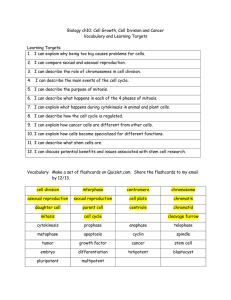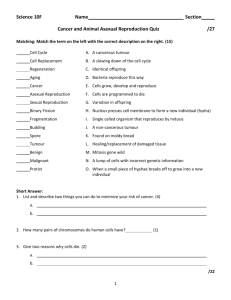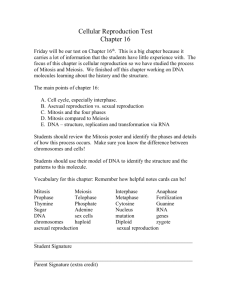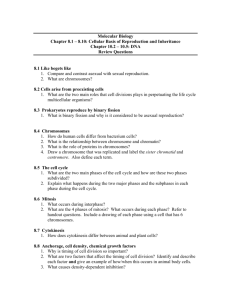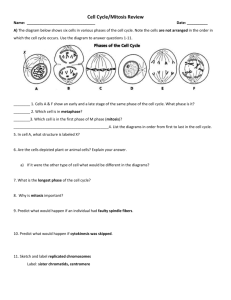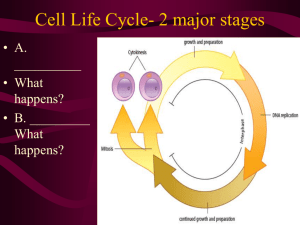Chapter 5 Study Guides
advertisement
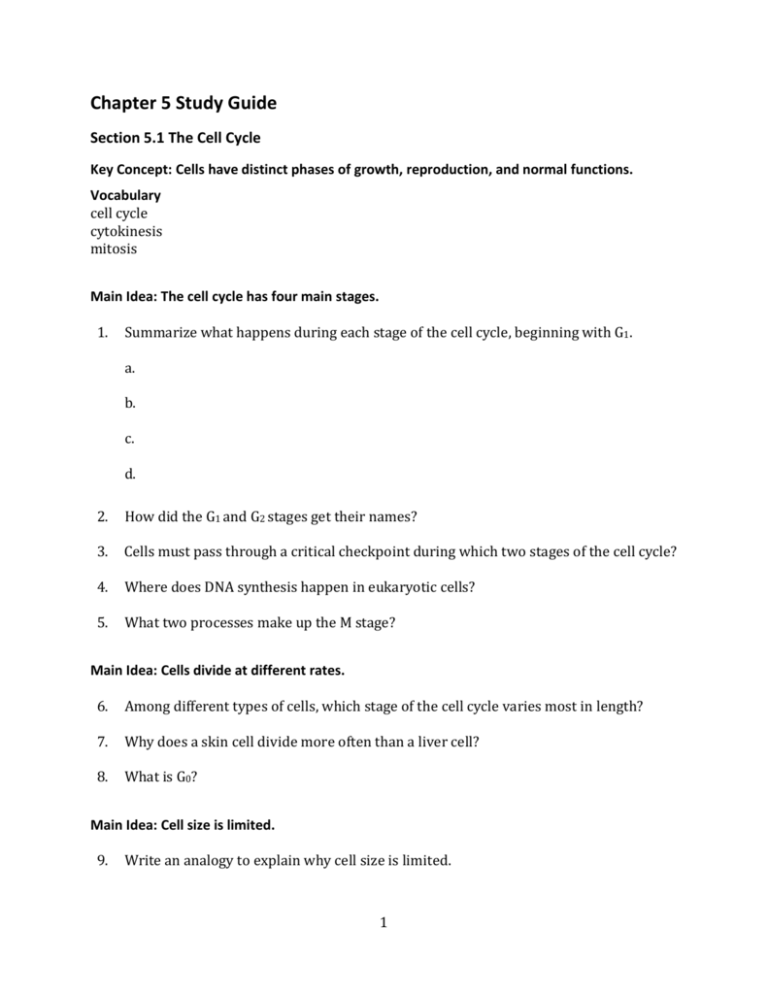
Chapter 5 Study Guide Section 5.1 The Cell Cycle Key Concept: Cells have distinct phases of growth, reproduction, and normal functions. Vocabulary cell cycle cytokinesis mitosis Main Idea: The cell cycle has four main stages. 1. Summarize what happens during each stage of the cell cycle, beginning with G1. a. b. c. d. 2. How did the G1 and G2 stages get their names? 3. Cells must pass through a critical checkpoint during which two stages of the cell cycle? 4. Where does DNA synthesis happen in eukaryotic cells? 5. What two processes make up the M stage? Main Idea: Cells divide at different rates. 6. Among different types of cells, which stage of the cell cycle varies most in length? 7. Why does a skin cell divide more often than a liver cell? 8. What is G0? Main Idea: Cell size is limited. 9. Write an analogy to explain why cell size is limited. 1 10. Which typically increases faster as a cell grows, surface area or volume? 11. For cells to stay the same size from generation to generation, what two things must be coordinated? Vocabulary Check 12. Think of an example of a cycle. What does this cycle have in common with the cell cycle? 13. What process divides a cell’s cytoplasm? How do the two word parts of your answer help you remember it? 14. What process divides the cell nucleus and its contents? Section 5.2 Mitosis and Cytokinesis Key Concept: Cells divide during mitosis and cytokinesis. Vocabulary chromosome histone chromatin chromatid centromere telomere prophase metaphase anaphase telophase Main Idea: Chromosomes condense at the start of mitosis. 1. What is a chromosome? 2. Why do chromosomes condense at the start of mitosis? 3. Why are chromosomes not condensed during all stages of the cell cycle? Main Idea: Mitosis and cytokinesis produce two genetically identical daughter cells. 4. How does interphase prepare a cell to divide? 5. Mitosis occurs in what types of cells? 6. Develop a device, such as a short sentence or phrase, to help you remember the order of the steps of mitosis: prophase, metaphase, anaphase, telophase. 2 7. How does cytokinesis differ between plant and animal cells? Vocabulary Check 8. DNA wraps around organizing proteins called ____________________ . 9. The suffix -tin indicates that something is stretched and thin. _________________ is the loose combination of DNA and proteins that looks sort of like spaghetti. 10. Sister chromatids are held together at the ____________________, which looks pinched. 11. The ends of DNA molecules form structures called ____________________ that help prevent the loss of genes. Section 5.3 Regulation of the Cell Cycle Key Concept: Cell cycle regulation is necessary for healthy growth. Vocabulary growth factor benign carcinogen apoptosis malignant cancer metastasize Main Idea: Internal and external factors regulate cell division. Complete the concept map below to show important ideas about growth factors. Type your answers in the numbered spaces provided below the diagram. 1. 2. 3 3. For questions 4–7, use the following words to fill in the blanks of the sequence diagram below. kinases cell division phosphorylate cyclins (4) ______________ activate (5) ______________, which (6) ______________ target molecules. This results in (7) ______________ . 8. What is apoptosis? Main Idea: Cell division is uncontrolled in cancer. 9. What type of disease may result if cell division is not properly regulated? 10. Complete the concept map below about cancer cells. Type your answers in the lettered spaces provided below the diagram. a. b. c. d. 11. List three ways mutations can occur in genes involved in cell-cycle regulation. Vocabulary Check 12. What does metastasize mean? 4 13. What is a substance known to produce or promote the development of cancer? Section 5.4 Asexual Reproduction Key Concept: Many organisms reproduce by cell division. Vocabulary asexual reproduction binary fission Main Idea: Binary fission is similar in function to mitosis. 1. Offspring resulting from asexual reproduction and those resulting from sexual reproduction differ in one major way. What is the difference? 2. Briefly describe the three steps of binary fission. For questions 2–4, fill in the chart below to highlight the advantages and disadvantages of asexual reproduction. Advantages 3. 4. 5. Disadvantages Main Idea: Some eukaryotes reproduce through mitosis. 6. If a eukaryotic organism reproduces through mitosis, what is true about the offspring and the parent organism? 7. In what types of organisms is mitotic reproduction most common? 8. List three examples of mitotic reproduction. 9. What forms of reproduction does the sea anemone use? Vocabulary Check 10. Write a word that starts with the letters “bi.” Explain what is similar between the meaning of the word you wrote and the meaning of “binary fission.” 5 11. What is the creation of offspring from only one parent organism called? Section 5.5 Multicellular Life Key Concept: Cells work together to carry out complex functions. Vocabulary tissue organ organ system cell differentiation stem cell Main Idea: Multicellular organisms depend on interactions among different cell types. Fill in the blanks below to represent organization in multicellular organisms. Cells make up (1.) ______________ make up (2.) ______________ make up (3.) ______________ 4. List two examples of tissues found in plants. 5. List two examples of organ systems found in plants. 6. How does an organism benefit from organ systems that work together and communicate? Main Idea: Specialized cells perform specific functions. 7. What is the process by which unspecialized cells develop into specialized cells? 8. Do different types of cells have different DNA? Explain. 9. What role does cell location play within a developing embryo? Main Idea: Stem cells can develop into different cell types. 10. Stems cells can be classified by their ability, or potential. The three classes of stem cells are: a. b. c. 6 11. Stem cells also can be classified by their _______________, as either adult or _____________. 12. List the three identifying characteristics of stem cells. 13. List one advantage of using adult stem cells and one advantage of using embryonic stem cells. Vocabulary Check 14. What is cell differentiation? 15. Organize the following words in order from the largest structure to the smallest structure: cell, organ, organ system, tissue Study Guide Questions Copyright © McDougal Littell/Houghton Mifflin Company 7
